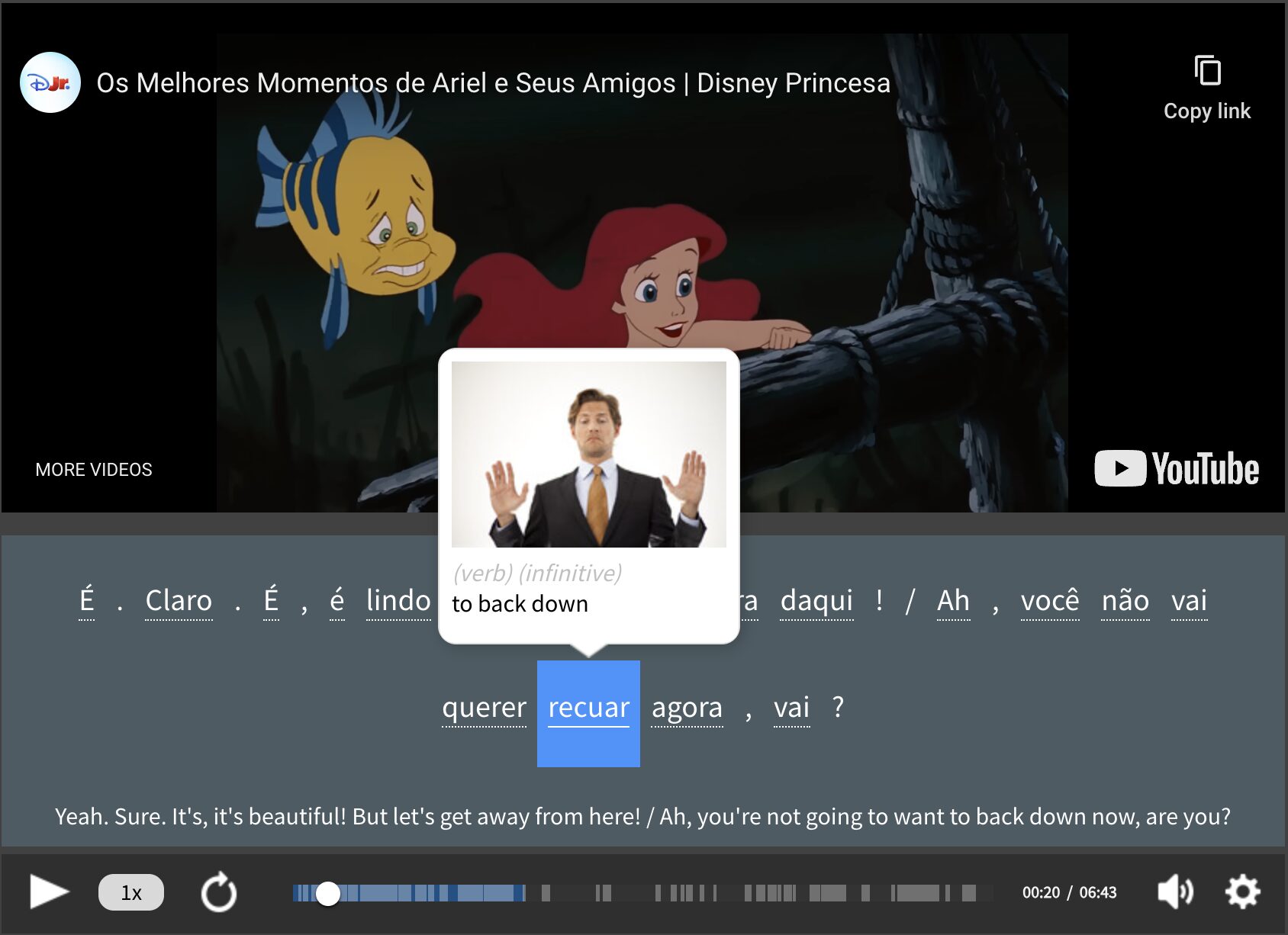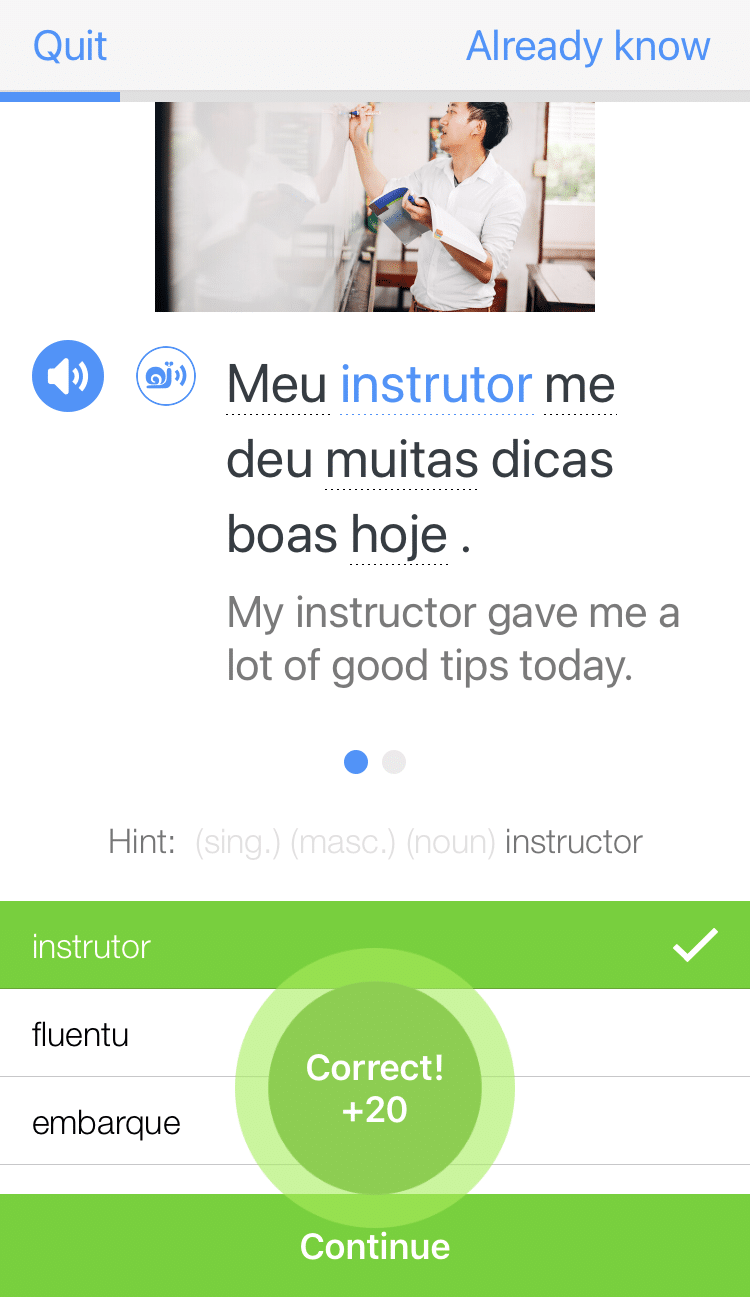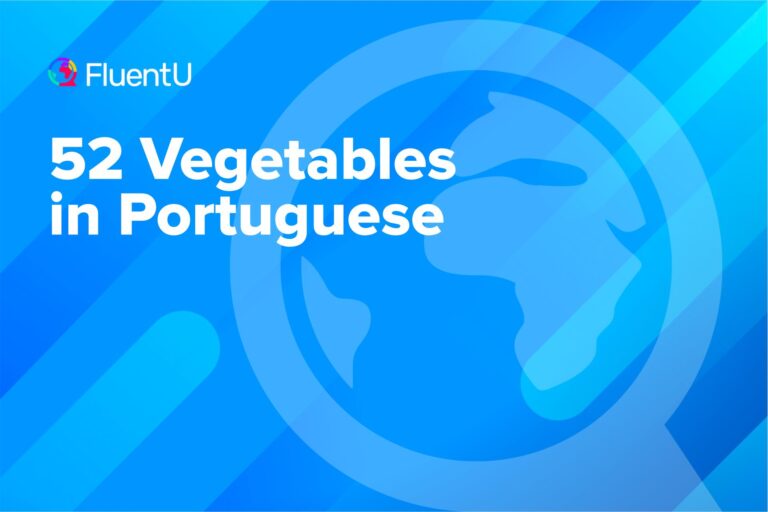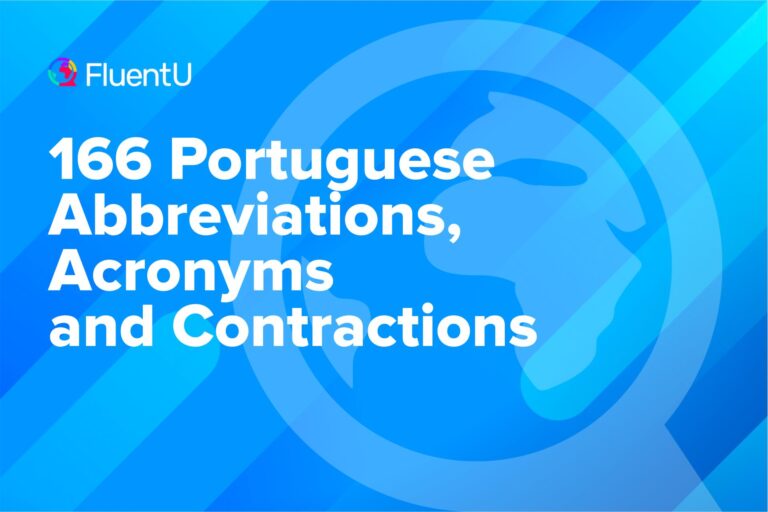The Complete Guide to Portuguese Pronouns

In Portuguese, there are many types of pronouns, from Portuguese personal pronouns like direct or indirect object pronouns to indefinite and possessive pronouns.
Whether you need to describe something you own, talk about a friend or express an opinion, you’ll encounter Portuguese pronouns everywhere. Let me teach you the most important Portuguese pronouns as well as how to use them with example sentences.
Download: This blog post is available as a convenient and portable PDF that you can take anywhere. Click here to get a copy. (Download)
Portuguese Personal Pronouns
In Portuguese, there are five kinds of personal pronouns (pronomes pessoais): subject, reflexive, direct object, indirect object and prepositional.
Subject Pronouns
Subject pronouns (pronomes subjetivos) are those that are used as the subject of a verb.
| Portuguese | English |
|---|---|
| Eu | I/Me |
| Você/Tu O senhor/A senhora | You (singular) |
| Ele/Ela | He/She |
| Nós/A gente | We/Us |
| Vós/Vocês | You (plural) |
| Eles/Elas | They |
Eu
Eu is the only word you use to say “I” in Portuguese. It’s the same for both a man and a woman and is in the first person. Here’s an example of how you’d use it:
Eu tenho fome. — I’m hungry.
Tu
It’s important to know that there are different ways of saying “you” depending on which dialect (Brazilian or European) you’re learning.
Tu is one of two main ways to say “you” in Portuguese.
How and how often tu is used depends on where you are. In Brazil, the informal “you” is você; tu is viewed as formal by some people, but in some areas in northeastern and southern Brazil, it’s used casually. When used, the verb that precedes it is often conjugated in the same way as você, which follows the same conjugation rules as the third person singular (he/she/it).
Tu tá me entendendo? — Do you understand me? (A Brazilian person, using tu very informally)
In Portugal, tu is the colloquial form of “you” and você is formal. People are more likely to use tu when speaking to a younger person or someone they’re more familiar with:
Tu estás feliz? — Are you happy? (Portugal)
Você
The other common way to say “you” is você, or its plural equivalent vocês. Again, where you are in the world affects how você is used.
In Brazil, this form is extremely common and is used in everyday conversation.
Você quer alguma coisa? — Would you like something? (Brazil)
In Portugal, você is used more formally, such as when you speak to someone who’s older than you. Note that, while você means “you,” it’s used with the third-person singular form of the verb. So instead of saying, você tens (you have) with the second-person singular form of the verb, which is incorrect, you’d say, você tem (you have).
O senhor and a senhora
If you want to take it a step further and show respect for your elders, you can use o senhor (sir) or a senhora (miss). O senhor and a senhora are formal ways of addressing someone of a higher rank, authority or prestige in Brazil. You use these words in place of “you,” but pair them with the third-person singular verb. For example:
A senhora pode me ajudar? — Could you help me?
A senhora gostaria de sentar aqui? — Would you [formal] like to sit here?
Ele and ela
If you’re referencing a masculine noun, you can use the word ele and if you’re referring to a feminine one, use ela. These are singular:
Ele é alto. — He’s tall.
Ela pensou que a festa ia ser hoje. — She thought the party would be today.
Nós and a gente
Nós is the most common form of “we”/“us” used in both Portuguese dialects, while a gente (literally, “the people”) is a colloquial Brazilian Portuguese way of saying “we”/“us.” (Note that the verb that follows a gente is conjugated in the first person singular.)
Nós estamos na praia. — We’re at the beach.
Nós vamos? — Are we going?
A gente vai? — Are we going?
A gente vai falar com a professora. — We’re going to talk to the teacher.
Vós
The pronoun vós isn’t used very much these days, but it’s still important to know. It’s considered more formal and archaic, but there are people in northern Portugal and northeastern Brazil that might use it.
Vós falastes com ele? — Have you all/you guys talked to him? (Portugal)
You’re more likely to read vós in old texts or historical fiction.
Eles and elas
To refer to a group of women or a plural noun that’s feminine, you use elas. When referring to a plural number of a masculine noun, use eles. If you’re referring to a group of both men and women, use eles as well.
Here are some examples of these pronouns in use:
Eles estão correndo bem rápido. — They’re [mas. or mixed] running very fast.
Elas querem festejar! — They [fem.] want to party!
Review
Here’s a quick rundown of which “you” pronouns to use on what occasions and places:
| Country | "You" Pronouns |
|---|---|
| Brazil | Informal: você, vocês Formal: tu, vós, o senhor, a senhora |
| Portugal | Informal: tu, vocês Formal: você, vós, o senhor, a senhora |
Differences Between English and Portuguese Subject Pronouns
While the main principles of pronouns are the same in English and Portuguese, Portuguese pronouns function more similarly to Spanish pronouns. Here are the main differences between English and Portuguese pronouns:
- You don’t always need to use the pronoun: If it’s clear who you’re talking to or about, you can omit the pronoun. This is usually the case when the conjugated verb can indicate who’s being talked about. For example, you can say either of these variations:
Eu estou escutando. (I’m listening.)
Estou escutando. (I’m listening.)Even though you don’t say the pronoun in the second example, the verb tells the listener that you’re referring to yourself since it’s in the first-person singular form. Once you get your verb conjugations down, you’ll be a pro at understanding what people are saying even without the pronouns.
- Third-person pronouns are dummy pronouns: A dummy pronoun is a pronoun that doesn’t refer to a specific gender, such as “it” in English. In Portuguese, you use ele or ela or the plural.
For example, if you’re talking about a dog in English, you might say: “It ate my homework!” In Portuguese, you’d say:
Ele comeu minha lição de casa!
Just determine if the noun “it” refers to is feminine or masculine. If it’s feminine, use ela and if it’s masculine, use ele.
- You can replace a second-person pronoun with a noun: This is only the case when you’re actually talking to that person and it implies the tu or você.
Oi! Colega, pode me ajudar? (Hey! Classmate, can you help me?)
Pai, quer comida? (Dad, do you want food?)
Reflexive Pronouns
Reflexive pronouns (pronomes reflexivos) can be used when dealing with reflexive verbs or when both the subject and the object of a sentence refer to a single individual.
Take extra care with this one, as many sentences that are reflexive in Portuguese aren’t reflexive in English.
| Portuguese | English |
|---|---|
| Me | Myself |
| Te/Ti/Se | Yourself |
| Se/Si | Himself/Herself/Itself |
| Nos | Ourselves |
| Vos | Yourselves |
| Se/Si | Yourselves/Themselves/Each other |
Me and nos usually precede a verb. In a phrase where these reflexive pronouns follow the verb, a hyphen is used to connect them.
Eu me lembro bem disso. — I myself remember this well.
Diga-me quando souber o que aconteceu. — Tell me when you know what happened.
Lavamo-nos no riacho. — We washed ourselves in the stream.
Se is used as “yourself” when it’s replacing você and is conjugated in the third person singular.
Você se aborreceu com ele? — Were you upset with him?
Se and si apply for both genders when talking about “himself”/“herself”/“itself” or “yourselves”/“themselves”/“each other.”
Ele/Ela se queimou. — He/She burned himself/herself.
Eles deram a si um intervalo. — They gave themselves a short break.
Vocês se falam. — You talk (among yourselves).
Vos is the reflexive of vós and is most commonly used in Portugal.
Vós vos lavastes no riacho. — You washed yourselves in the stream.
Direct Object Pronouns
A direct object pronoun (pronome de objeto direto) is used to replace an object (usually a noun) to avoid repetition.
Typically these go before a verb, though more complex sentence structures will place them after.
| Portuguese | English |
|---|---|
| Me | Me |
| Te | You |
| O/A Lo/La | Him/Her/It |
| Nos | Us |
| Vos | You (plural) |
| Os/As Los/Las | Them |
For “him”/“her”/“it”: o/a are placed before a verb, while lo/la are typically placed after a verb. The same rule applies to the plural forms (os/as, los/las).
Eu a conheço há anos. — I’ve known her for years.
Eu vou conhecê-lo amanhã. — I’ll meet him tomorrow.
Eu quero chamá-los para sair para jantar. — I want to invite them to go out for dinner.
Nos can be used before or after a verb.
Ela quer nos dar uma ajuda. — She wants to give us some help.
Ele vai dar-nos o seu apoio. — He’ll give us his support.
Indirect Object Pronouns
An indirect object pronoun (pronome de objeto indireto) replaces the indirect object (usually a noun) in a sentence to avoid repetition.
Essentially, indirect object pronouns are concerned with things that are for the person being described.
| Portuguese | English |
|---|---|
| Mim | (To/for) Me |
| Lhe/Te, Para ti/Para você Para o senhor/Para a senhora | (To/for) You |
| Lhe/Para ele/Para ela | (To/for) Him/her |
| Nos/Para Nós | (To/for) Us |
| Lhes/Para Vocês | (To/for) You (plural) |
| Lhes/Para Eles/Para Elas | (To/for) Them |
Mim is always preceded by a preposition like para (to or for) or de (of).
Comprei esse relógio para mim. — I bought this watch for myself.
Lhe is neutral in gender and can be used in the second- or third-person singular. The same rule applies to lhes and the second- and third- person plurals.
Eu lhe dei um presente. — I gave a present to him/her.
Prepositional Pronouns
Prepositions often connect people, objects, time or locations of a sentence. These pronouns are used to show the relationship between things in a way that avoids repetition.
Prepositional pronouns (pronomes preposicionais) differ from direct and indirect object pronouns in that they always follow a preposition, like de (of), em (in) or com (with).
| Portuguese | English |
|---|---|
| Mim/Comigo | Me/With me |
| Você/Si/Consigo Tu/Ti/Contigo | You/With you |
| Ele/Ela | Him/Her |
| Nós/Conosco/Connosco | Us/With us |
| Eles/Elas | Them |
In some forms, the prepositional pronouns double up as a contraction of the pronoun and the preposition com (with). For instance com + ti = contigo; com + nós = connosco/conosco.
Eles querem ir comigo. — They want to go with me.
Eu queria ir contigo. — I wanted to go with you.
Conosco is used in Brazil, while connosco is the preferred spelling in Portugal.
Por que não viaja conosco? — Why won’t you travel with us? (Brazilian Portuguese)
Por que não viajas connosco? — Why won’t you travel with us? (European Portuguese)
Com nós (without any contractions) is typically employed when the number of people or objects is specified.
Ele discutiu o problema com nós três. — He discussed the problem with the three of us. (Literally, “with us three”)
Portuguese Possessive Pronouns
Possessive pronouns (pronomes possessivos) are there to show ownership.
Sometimes the definitive articles o, a, os and as (the) precede possessive pronouns, but often they’re omitted.
| Portuguese | English |
|---|---|
| Meu/Meus (masc.) Minha/Minhas (fem.) | My/Mine |
| Teu/Teus (masc.) Tua/Tuas (fem.) Seu/Seus (masc.) Sua/Suas (fem.) | Your/Yours (singular) |
| Dele/Dela | His/Hers/Its |
| Nosso/Nossos (masc.) Nossa/Nossas (fem.) | Our/Ours |
| Vosso/Vossos (masc.) Vossa/Vossas (fem.) | Your/Yours (plural) |
| Deles/Delas | Their/Theirs |
When using possessive pronouns, you must agree in gender and number with the thing described.
Meu computador — My computer (singular, masculine)
Minha casa — My house (singular, feminine)
Meus cachorros — My dogs (plural, masculine)
Minhas melhores amigas — My best (girl) friends (plural, feminine)
Teu/tua/teus/tuas are used for tu, while seu/sua/seus/suas are used for você.
(As) Tuas amigas — Your (female) friends
(O) Seu vizinho — Your (male) neighbor
Vosso/vossa/vossos/vossas are used with vós and are exclusively used in European Portuguese.
Ponha isto na vossa mala. — Put this in your suitcase.
Emprestei o vosso casaco. — I borrowed your coat.
Dele/deles (masc.) and dela/delas agree in gender and number with the person who owns the thing described. This is unlike all other possessive pronouns, which agree in gender and number with the noun that follows them.
As irmãs deles — Their sisters (when “their” refers to men/boys)
Os irmãos delas — Their brothers (when “their” refers to women/girls)
Portuguese Demonstrative Pronouns
Demonstrative pronouns (pronomes demonstrativos) showcase an object in relation to the person speaking. In Portuguese, these can be variable (either masculine or feminine) or invariable (gender-neutral).
These pronouns take into consideration both the physical and temporal distance of the objects being described.
| Portuguese | English |
|---|---|
| Este/Esta Isto | This |
| Estes/Estas | These |
| Esse/Essa/Isso Aquele/Aquela/Aquilo | That |
| Esses/Essas Aqueles/Aquelas | Those |
For “this” and “these”: Este/esta (masculine/feminine) and estes/estas are variable pronouns used to demonstrate something close to the speaker and/or something closer in time.
Vou escrever uma carta esta semana. — I’ll write a letter this week.
Isto is invariable, but is used to demonstrate objects in the same manner.
Isto é perfeito para mim. — This is perfect for me.
For “that” and “those”: the variable esse/essa/esses/essas and invariable isso are used when an object is closer to the person being spoken to (e.g., “that box you’re holding”) or it’s being described in the context of a recent past or future event the speaker and listener were involved in (“that restaurant we visited”; “that coffee shop we’ll be meeting at later”).
Esse cachorro é do meu vizinho. — That dog is my neighbor’s.
Isso é muito caro. — That’s very expensive.
Aquele/aquela/aqueles/aquelas (variable) and aquilo (invariable) are used when talking about something that’s really far away or in the distant past.
Você encontrou aquelas chaves que tinha perdido? — Did you find those keys that you lost?
Aquilo me ofendeu. — That offended me (at the time).
Portuguese Relative Pronouns
Relative pronouns (pronomes relativos) are used to refer back to a previously used noun or pronoun, connecting it to another element in a sentence.
| Portuguese | English |
|---|---|
| Que | Who/Whom/Which/That |
| Quem | Who/Whom |
| Qual/Quais | That/Which/Who/Whom |
| Cujo/Cujos (masc.) Cuja/Cujas (fem.) | Whose |
| Onde | Where |
Que can be used with a preposition like em (in) or on its own.
O homem que me telefonou. — The man who called me.
A casa em que ela mora. — The house in which she lives.
Quem is used when talking about a person or a personified object, and always has a preposition before it.
O funcionário por quem fomos assistidos foi muito gentil. — The employee by whom we were helped was very kind.
Definite articles (o/a, os/as) must precede qual (singular) and quais (plural) and they must agree with the gender of the subject/noun referred to.
O jogador sobre o qual eu falei foi premiado ontem. — The player who I talked about won an award yesterday.
Falamos com a prima dele, a qual mora na Inglaterra. — We talked to his (female) cousin who lives in England.
Cujo/cujos/cuja/cujas agree in gender and number with the possessed object, not its owner.
Patrícia é a estudante cujo trabalho foi muito elogiado. — Patrícia is the student whose work was greatly praised.
Onde is a synonym of em que (in which) and always refers to places.
A casa onde eu cresci foi demolida. — The house where I grew up was demolished.
Portuguese Interrogative Pronouns
As you might’ve guessed, interrogative pronouns (pronomes interrogativos) are used when formulating questions about ownership.
| Portuguese | English |
|---|---|
| Como | How/What |
| Que/O que | What |
| De que/Em que/Para que | What about/In which/What for |
| Por que | Why |
| Qual/Quais | What/Which |
| Quem | Who/Whom |
| Com quem/De quem/Em quem/Para quem | With whom/About whom/In whom/To or for whom |
| Onde/De onde/Para onde | Where/From where/To where |
| Quando | When |
| Quanto/Quantos (masc.) Quanta/Quantas (fem.) | How many/How much |
Que (what) is always followed by a noun; o que is typically followed by a verb.
Que dia é hoje? — What day is it today?
O que posso fazer? — What can I do?
When por que (why) is used at the end of a sentence, or as a standalone question, the quê is spelled with a circumflex accent. It’s also worth noting that porque means “because” and o porquê is “the reason why.”
Por que ele faltou à aula? — Why did he miss class?
Ela não quer falar comigo? Eu posso saber por quê? — She doesn’t want to talk to me? Can you tell me why?
Qual/quais (which) implies a choice and doesn’t always have to be followed by a noun.
Eu não sei qual é o meu favorito. — I don’t know which is my favorite.
Quais dias eles estarão disponíveis? — What/Which days will they be available?
Quanto/quantos and quanta/quantas agree in gender and number with the associated object.
Sua filha tem quantos anos? — How old is your daughter? (Literally, “how many years does your daughter have?”)
Eu preciso de quantas maçãs para essa receita? — How many apples will I need for this recipe?
Portuguese Indefinite Pronouns
Lastly, we have indefinite pronouns (pronomes indefinidos), which are used to refer to people or objects that are identifiable in a sentence but not specified explicitly.
| Portuguese | English |
|---|---|
| Tudo | Everything |
| Nada | Nothing/Anything |
| Mais; Menos | More; Less |
| Alguém/Ninguém | Somebody/Anybody; Nobody/No one |
| Algum/Alguns; Nenhum/Nenhuns (masc.) Alguma/Algumas; Nenhuma/Nenhumas (fem.) | Some/Any; None |
| Tanto/Tantos (masc.) Tanta/Tantas (fem.) | So much/So many |
| Poucos/Poucas; Muitos/Muitas | Few; Many |
| Pouco/Pouca; Muito/Muita | Little; Much |
| Vários/Várias | Several |
| Todo/Toda | Whole/Entire |
| Todos/Todas | Every/All |
Nada can be used in affirmative, negative or interrogative sentences. The word não (no or not) + a verb usually precedes it.
Nós não sabíamos de nada. — We didn’t know anything.
Você não tem mais nada a adicionar? — Don’t you have anything else to add?
Alguém (somebody/anybody) and ninguém (nobody/no one) can be used in both affirmative and interrogative sentences.
Alguém veio te ajudar? — Did someone come to help you?
Eu não conheço ninguém aqui. — I don’t know anyone here.
Ninguém quer falar comigo. — Nobody wants to talk to me.
When todo/toda takes the meaning of “each” or “all,” a definite article isn’t needed. When talking about an entire thing, a definite article is required.
Eu ligo para ela todo dia. — I call her every day.
Ele ficou o dia todo fora de casa. — He was away from home all day.
Todos/todas are always followed by the indefinite articles os and as.
Eu corro todas as manhãs. — I run every morning.
Nós contamos todos os itens. — We counted all the items.
Tudo, nada, alguém and ninguém are all invariable. Every other indefinite pronoun must agree in gender and number with its corresponding subject/noun.
Ele me contou tudo. — He told me everything.
Ele tem poucos amigos. — He has few friends.
Ele tem poucas amigas. — He has few (female) friends.
How to Practice Portuguese Pronouns
There are loads of ways to practice Portuguese pronouns. If you need some inspiration, here are a few suggestions:
- Create your own sentences. By creating your own sentences you’ll be able to practice spelling, grammar and pronunciation all in one single study session! Either write these down in a notebook or type them out in a Word document. Then, proofread to check you’ve got your spelling/grammar right and read them aloud to yourself a few times so you can nail your chosen Portuguese dialect.
- Immerse yourself in native Portuguese content. These pronouns will often appear in everyday Portuguese conversations and writing, so there are plenty of resources available for you to choose from, such as TV shows and news sources.
For example, notice how often pronouns are used in this Portuguese-dubbed clip from “Friends”:
- Listen to some Portuguese language songs. Portuguese songs are great for identifying and hearing Portuguese pronouns used in context. For an additional challenge, try to write down the pronouns you hear, then listen to the song a second time with the lyrics in front of you so you can see how much you picked up on.
One useful resource for music and other native media is FluentU, a language learning program that offers an array of authentic Portuguese videos with interactive subtitles and accompanying quizzes. You can even search for specific vocabulary or pronouns from this post to see more examples of them used in context.
FluentU takes authentic videos—like music videos, movie trailers, news and inspiring talks—and turns them into personalized language learning lessons.
You can try FluentU for free for 2 weeks. Click here to check out the website or download the iOS app or Android app.
Portuguese Pronouns Quiz
Fill in the blanks with the pronoun that fits the sentence!
1. _____ sou a pessoa mais linda aqui. (I am the most beautiful person here.)
2. _____ quer jantar comigo? (Do you want to eat dinner with me?)
3. De manhã, _____ encontramos na estação de ônibus antes de irmos a pé para a universidade. (In the morning, we meet at the bus station before walking to university.)
4. Ela sempre _____ levanta cedo para sair para correr. (She always gets up early to go for a run.)
5. Eu _____ convidei para jantar na minha casa. (I invited him to have dinner at my house.)
6. Mesmo que não pudessem vir ao casamento, eles _____ enviaram um presente lindo. (Even though they couldn’t come to the wedding, they sent us a beautiful present.)
7. O meio ambiente é muito importante _____. (The environment is very important to me.)
8. Encontrei este livro _____. Espero que ele goste! (I found this book for him. I hope he likes it!)
9. Vocês querem vir a São Paulo _____ neste fim de semana? (Do you want to come to São Paulo with me this weekend?)
10. Ele trouxe muitos lanches _____ para a viagem de ônibus. (He brought lots of snacks with him for the bus journey.)
11. Eu acho que aquela mochila é _____! Ele me disse que a tinha perdido. (I think that’s his backpack! He told me that he had lost it.)
12. _____ passaportes estão sobre a mesa, ao lado da garrafa de água. (Our passports are on the table next to the bottle of water.)
13. _____ cidade sempre foi especial para mim. (This city has always been special to me.)
14. Onde você comprou _____ sapatos? Eu adoro eles! (Where did you buy those shoes? I love them!)
15. Este é meu amigo _____ conheci enquanto estudava no Porto! (This is my friend who I met while studying in Porto!)
16. Não sei _____ deixei meu celular. Você pode ligar para o meu número? (I don’t know where I left my cell phone. Can you call my number?)
17. _____ animais de estimação você tem? (How many pets do you have?)
18. _____ você decidiu estudar outra língua? (Why did you decide to study another language?)
19. Há _____ pessoas na praia hoje! (There are so many people at the beach today!)
20. _____ vai estudar na biblioteca depois da aula? (Is anyone going to study in the library after class?)
Solutions:
1. Eu
2. Você
3. Nos
4. Se
5. O
6. Nos
7. Para mim
8. Para ele
9. Comigo
10. Consigo
11. Dele
12. Nossos
13. Esta
14. Esses
15. Que
16. Onde
17. Quantos
18. Por que
19. Tantas
20. Alguém
Now that you’ve seen all of the Portuguese pronouns, it’s time to put your knowledge into practice!
Be creative and don’t be afraid to mix and match different learning techniques to see what works for you. Whether you’re reading the news, listening to a podcast or watching a movie, you’ll always be exposed to Portuguese pronouns. Opportunities are plentiful, so make sure you’re getting the most out of them.
Download: This blog post is available as a convenient and portable PDF that you can take anywhere. Click here to get a copy. (Download)
And One More Thing...
If you're like me and enjoy learning Portuguese through movies and other media, you should check out FluentU. With FluentU, you can turn any subtitled content on YouTube or Netflix into an engaging language lesson.
I also love that FluentU has a huge library of videos picked specifically for Portuguese learners. No more searching for good content—it's all in one place!

One of my favorite features is the interactive captions. You can tap on any word to see an image, definition, and examples, which makes it so much easier to understand and remember.
And if you're worried about forgetting new words, FluentU has you covered. You'll complete fun exercises to reinforce vocabulary and be reminded when it’s time to review, so you actually retain what you’ve learned.
You can use FluentU on your computer or tablet, or download the app from the App Store or Google Play. Click here to take advantage of our current sale! (Expires at the end of this month.)










